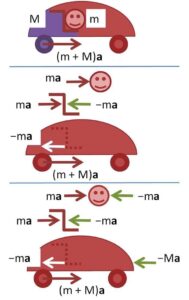Table of Contents
Pseudo force occurs when the frame of reference begins to accelerate in comparison to a non-accelerating frame.
The force F is generated by the acceleration ‘a’ of the non-inertial reference frame itself, not by any physical interaction between two objects. As a frame may accelerate in any arbitrary manner, so can phantom forces (but only in direct response to the acceleration of the frame).
Pseudo Force Examples:
Consider a person waiting at a bus stop observing a speeding automobile. He infers that a force is being exerted on the car and that it is accelerating. There is no issue here, and the pseudo-force idea is not necessary.
However, suppose the person inside the accelerating automobile looks at the person standing at the bus stop. In that case, he notices that the person is accelerating in relation to the car, despite no force acting on it. The idea of pseudo-force is necessary to transform the non-inertial frame of reference to an equivalent inertial frame of reference.
Meaning of Pseudo Force
The term ‘pseudo’ refers to something that is fictional, fake, or does not exist but only exists in our minds. A force is something we use to push, pull, or roll an object over a surface.
When we talk about pseudo force, we’re talking about a fictitious force. That no longer exists, but we still regard it to be a component in studying the nature of forces in Physics.
Assume there are two bodies, P and Q, in an accelerated metro, and R views both of them from the platform. In this case, if R draws a free body diagram of Q, it will have a net force that gives acceleration; however, if P draws a free body diagram or FBD for Q, Q is at rest, so to counter the force shown by P, Q needs a fictitious force in his frame, and this fictitious force is nothing more than the pseudo force.
Explanation of Pseudo Force
In the preceding paragraph, we said that a pseudo force is also known as a fictional force. When a frame of reference accelerates in comparison to a non-accelerating frame, a fake force is created. Assume a person is standing at a bus stop and observes an accelerating automobile; he deduces that when a force is applied to the car, it accelerates.
What happens next is that if the same person A sits in his car and observes another person B standing in his place at the bus stop, he notices that even though no force acts on the standing person, the person A notices that person B is moving arbitrarily along with his car but in the opposite direction.
Consider another case in which a father pushes a swing for his child, and the swing performs an oscillatory motion, causing a force to work on it in an attempt to lessen its speed, and the swing ultimately comes to rest. So, a force is acting here, but we don’t know from which direction or what amount of force is acting on the swing. So, when a youngster swings, he perceives air flowing beside him, so it is once again a fake force.

Examples of Pseudo Force-
Example 1. Consider the following scenario: a ball is hanged from the roof of a train by an inextensible cord. No, if the train is at rest or travelling at a constant pace in a straight line, the string will remain vertical, and passengers will conclude that the total force acting on the ball is zero.
Assume that when the train begins to accelerate, the string begins to make an angle with respect to the vertical while moving to and fro.
There are two forces acting on a traveller in this condition, and they are not collinear; nonetheless, the ball seems to remain in an equilibrium state (as long as the acceleration of the train remains constant). The idea of pseudo force is necessary in this sort of situation.
Example 2: Elevator case study
Let us learn more about pseudo forces using real-world instances. We were all trapped in the elevator. When we are travelling up in the elevator, we feel heavier than when we are heading down.
Consider the following scenario: a person with mass m stands on a weighing machine in a stationary elevator. A person’s actual weight is mg. The weighing machine has a normal response N, and the weight’mg’ is a readout from it. The weight of the guy is determined by the velocity of the elevator.
FAQs
What exactly is a pseudo-force?
Assume two passengers, A, and B, are riding in a speeding bus, and C is watching them from the ground. If C draws a free-body diagram of B, it will have a net force that causes acceleration. However, if A draws a free-body diagram for B, B is at rest for him. Thus he requires a fake force in his frame to counteract the force depicted by A. Pseudo force is the name given to this force.
Is centrifugal and centripetal force always equal?
This isn't required. Both forces will be comparable if we are in a frame of reference where the body is at rest in the radial direction. However, if a body has a radial acceleration with respect to a frame, centripetal force will not equal centrifugal force in that frame.
What is the role of these factors in problem-solving?
Assume we have a little block traveling up a wedge at a constant rate. The moment the little block reaches the top of the wedge must be determined. When we are in the wedge frame of reference, it is much easier to analyze this scenario since the Free Body Diagram will have an additional pseudo force as the wedge accelerates.
Is the work performed by these forces relevant to the work-energy theorem?
We must account for the work done by pseudo forces when applying the work-energy theorem from a non-inertial frame of reference.








